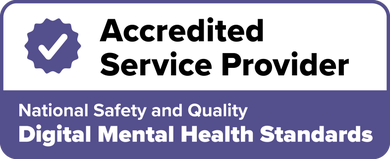Premenstrual dysphoric disorder (PMDD) explained
In a Nutshell
PMDD is a serious health condition that causes intense emotional and physical symptoms before your period. It’s more than PMS and often affects how you feel, think, and function.
It’s estimated that between 2 to 8% of women experience PMDD, which is about 60 million women globally.
If you notice a monthly pattern of distressing symptoms, tracking them and speaking to a healthcare professional can help you find the right support and treatment.
Suppose the days leading up to your period leave you feeling emotionally down, anxious, or withdrawn, and this happens regularly. In that case, it’s possible that you’re dealing with more than just typical premenstrual symptoms.
Premenstrual Dysphoric Disorder, or PMDD, is a recognised medical condition that causes intense emotional and physical changes in the second half of the menstrual cycle. These symptoms can be distressing and difficult to live with, and it doesn’t help that they recur every month.
How is PMDD different from PMS?
Most women experience symptoms of premenstrual syndrome (PMS) like irritability, bloating, or mood changes, which are generally mild and manageable. But PMDD is more intense. It includes severe emotional symptoms such as depression, anxiety, and anger that usually start one to two weeks before your period and ease once menstruation begins.
Women with PMDD often say they feel like a completely different version of themselves each cycle, with symptoms that interfere with their work, relationships, and daily functioning.
What causes PMDD?
PMDD is thought to result from how your body responds to normal hormonal changes in the menstrual cycle. While hormone levels may not be unusual, women with PMDD may be more sensitive to the shifts in oestrogen and progesterone that occur after ovulation.
These hormonal changes affect neurotransmitters like serotonin, which influences your mood and emotions.
There may also be links between PMDD and a history of trauma, mental health conditions, or a family history of similar symptoms. However, more studies are needed to really pinpoint the root causes of PMDD.
Risk factors
Several factors may increase the likelihood of developing PMDD, including:
A personal or family history of depression, anxiety, or trauma
Sensitivity to hormonal changes
High stress levels
Smoking or substance use
Other hormonal or reproductive health conditions
Common signs of PMDD
Symptoms of PMDD usually begin after ovulation and resolve shortly after your period starts. The most noticeable signs are emotional or behavioural, though physical and cognitive symptoms often appear too.
Emotional and behavioural symptoms
Feeling unusually sad, hopeless, or tearful
Intense irritability or anger, often affecting relationships
Anxiety or feeling overwhelmed
Mood swings or emotional sensitivity
Losing interest in things you normally enjoy
Difficulty concentrating or thinking clearly
Withdrawal from others
Suicidal thoughts, in severe cases
Physical and cognitive symptoms
Fatigue or low energy
Trouble sleeping or sleeping too much
Food cravings or appetite changes
Bloating, breast tenderness, or headaches
Joint or muscle pain
Brain fog or difficulty remembering things
Changes in libido
How does PMDD affect everyday life?
PMDD symptoms tend to repeat each cycle and can seriously influence or even limit how you function. You may find it hard to keep up at work, connect with your loved ones, or stay consistent with your usual routines.
Many women describe a feeling of dread knowing this part of their cycle is approaching, and some feel isolated or misunderstood because others don’t see how difficult it is.
How do you get diagnosed with PMDD?
If you think PMDD might be affecting you, the first step is to start tracking your symptoms. Use a diary, app, or calendar to note how you’re feeling emotionally and physically each day, as well as when your period starts and ends.
Do this for at least two cycles. This record will help identify patterns and provide valuable information for your doctor.
When you're ready to speak with someone, your GP (general practitioner) is a good starting point. They can review your symptom history, rule out other conditions, and refer you to a specialist if needed.
Depending on your symptoms and medical history, you may be referred to a gynaecologist, endocrinologist, or mental health professional, such as a psychologist or psychiatrist with experience in hormone-related mood disorders.
What your healthcare provider will consider
To make a diagnosis, a doctor will usually:
Look for a clear pattern where symptoms appear after ovulation and improve soon after your period starts
Confirm that symptoms are present in most cycles and are not ongoing throughout the entire month
Assess whether symptoms interfere with your work, relationships, or daily life
Rule out other physical or mental health conditions, such as depression, anxiety, thyroid disorders, or chronic fatigue
Diagnosis is based on guidelines from the DSM-5, which require at least five symptoms, including one related to mood, to be present during the luteal phase and to improve shortly after menstruation begins.
A supportive GP can guide you through this process, help interpret your symptom tracking, and connect you with the right team to move forward.
Why a diagnosis might get delayed
PMDD is sometimes mistaken for other conditions, particularly when mood symptoms are the most visible. Some women are told they have depression or anxiety without any link made to their cycle.
In other cases, their symptoms are dismissed as ordinary PMS. Clear, consistent tracking can help your doctor make a more accurate diagnosis and recommend the right support.
What are the treatment options?
Treatment depends on your symptoms, health history, and personal goals, including whether you want to have children in the future. Many women find that combining self-care and medical support brings the best results.
Self-care and lifestyle support
Exercise can help lift your mood and ease tension
Balanced nutrition can support hormone and energy levels
Mindfulness or relaxation techniques may reduce anxiety
Good sleep habits improve emotional and physical resilience
Tracking your symptoms will give insights into your cycle and help with planning
These strategies can make daily life feel more manageable, especially when paired with clinical treatment.
Medical support
Antidepressants (SSRIs): These may be prescribed either daily or only during the luteal phase and are often effective in easing emotional symptoms
Hormonal contraception: Some birth control pills, particularly those with drospirenone, help regulate hormonal fluctuations that can trigger symptoms
Cognitive Behavioural Therapy (CBT): Therapy can be useful for managing thoughts, building coping skills, and improving emotional resilience
GnRH agonists or surgery: These are used in rare, severe cases and work by stopping ovulation entirely. These options affect fertility and come with side effects, so they are usually considered only when other treatments haven’t worked
It's important to speak with a qualified medical professional before starting or changing any treatment. PMDD affects each person differently, and what works for one woman may not be right for another.
Avoid self-medicating, as some treatments can interact with or affect other health conditions. A doctor can guide you safely through your options and help you find a treatment plan that fits your needs.
Final thoughts
Living with PMDD can feel unpredictable and exhausting, especially if others don’t fully understand what you’re going through. But this condition is recognised and treatable.
If you're noticing a pattern of mood and physical symptoms that disrupts your life every month, consider speaking to your GP or a mental health professional as soon as possible.
Get Help
Overcome your women's issues and book a free online consultation with one of our top rated therapists
Essential Reading about Women's Issues
Free Mental Health Tests
FAQs on Premenstrual Dysphoric Disorder
PMDD includes more severe emotional and physical symptoms than PMS and has a stronger impact on daily life. PMS may cause discomfort, but PMDD can feel emotionally overwhelming and often affects your work, relationships, and mental health.
PMDD itself doesn’t usually affect fertility. However, some treatments may impact your ability to conceive. It’s advisable to talk with your doctor about your reproductive plans before starting any long-term treatments.
Track your mood, energy, sleep, appetite, and physical symptoms daily. Note when your period starts and ends. Try to do this for at least two menstrual cycles to help identify any patterns. You can also explore mood tracking apps to help you with this.
Some women manage symptoms through self-care and mental health therapy alone, especially if symptoms are mild. If symptoms are more intense, medical treatment may be a necessary part of a broader support plan.
If you're feeling unsafe, having thoughts of self-harm, or struggling to care for yourself, it's important to seek help straight away. It's best to call a crisis support service, but you can also contact your GP or therapist.
Women's Issues Therapists Available Now
NSW
Psychologist
I'm a registered psychologist with over 10 years of experience supporting children, parents, and adults to navigate life's challenges with greater confidence and ease. My...More
NSW
Clinical Psychologist
Hi, I am a clinical psychologist who takes a special interest in supporting women with stress, anxiety disorders, depression, trauma, burnout, pre-menstrual dysphoric dis...More








